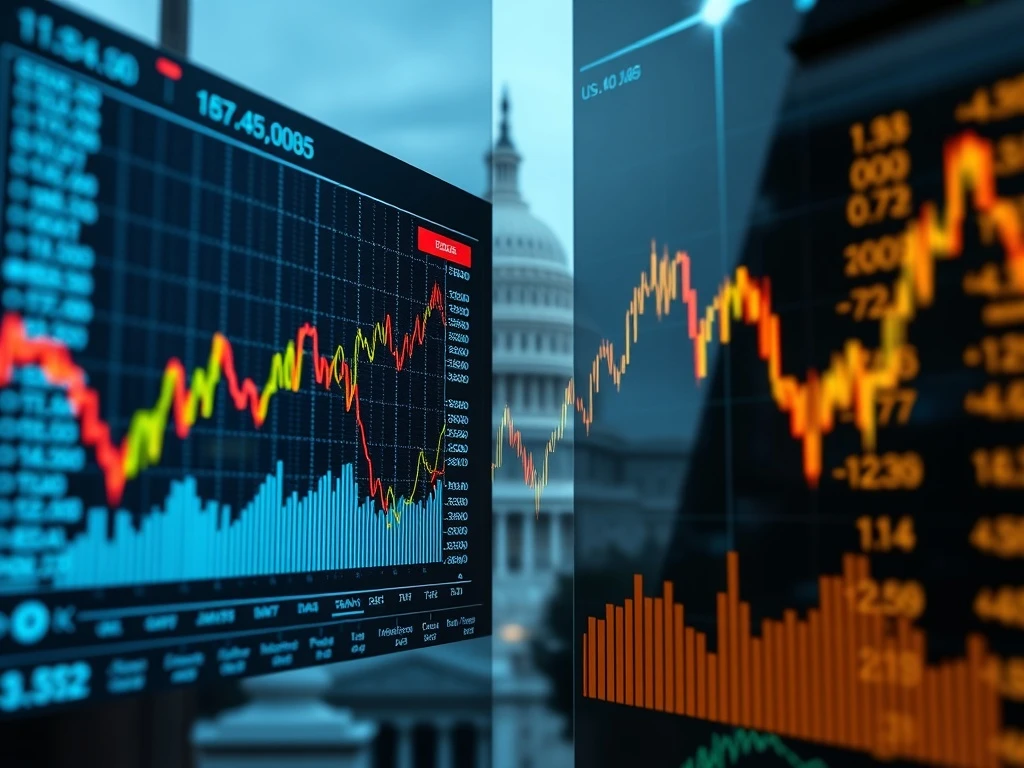U.S. stock futures showed little change in early trading this week. Investors adopted a noticeably cautious stance. They keenly await crucial inflation reports. These upcoming reports could significantly shape Federal Reserve policy. Therefore, market participants are watching closely. This period of stability precedes the release of significant economic data. Consequently, many investors are holding back. They prefer to see the latest figures before making major moves. This calm before the storm highlights market anticipation.
Understanding the Stasis in U.S. Stock Futures
U.S. stock futures represent agreements to buy or sell a stock index at a predetermined price on a future date. They offer an early glimpse into overall market sentiment. Futures allow investors to hedge against potential risks. Furthermore, they enable speculation on future price movements. Currently, these futures indicate a holding pattern. This suggests widespread investor caution across the board. No major catalysts are driving prices sharply in one direction. Instead, market participants are pausing. They await clearer signals from impending economic data. This wait-and-see approach is quite common during periods of high uncertainty. Ultimately, the market seeks direction from fundamental economic indicators.
The Critical Role of Upcoming Inflation Reports
This week brings vital inflation data releases. The Consumer Price Index (CPI) report is highly anticipated. It measures changes in the prices of goods and services purchased by consumers. This report covers a wide range of items, from food to housing. Another key release is the Producer Price Index (PPI). PPI tracks average changes in selling prices received by domestic producers. It often serves as an early indicator of consumer inflation. These reports are essential for economic analysis. They provide critical insights into current inflationary pressures. High inflation erodes purchasing power for consumers. Moreover, it impacts corporate profitability. Consequently, these figures significantly influence central bank decisions regarding interest rates. Policy makers rely on this data heavily.
Inflation’s Direct Impact on U.S. Stock Futures
Inflation data directly influences Federal Reserve actions. If inflation remains elevated, the Fed might keep interest rates higher for longer. Higher rates increase borrowing costs for businesses and consumers. This can reduce corporate earnings significantly. Furthermore, it makes equity investments less attractive compared to bonds. Conversely, moderating inflation could signal potential rate cuts. Lower interest rates typically boost economic activity. They also make stocks more appealing to investors. Therefore, the upcoming reports will largely guide interest rate expectations. This, in turn, directly affects U.S. stock futures valuations. Specific sectors often react differently. Growth stocks, for example, frequently suffer more from higher rates. However, value stocks might show greater resilience during such periods. Investors should consider these varied impacts.
Navigating Market Volatility and Investor Strategy
Investors face a period of potential volatility. The inflation reports could trigger sharp market moves in either direction. Prudent investors often review their portfolios carefully. They consider diversification as a key strategy to mitigate risks. Long-term investors typically focus on fundamental strength and company performance. Short-term traders, however, might seek opportunities in immediate price swings. Staying informed is absolutely paramount. Understanding the nuances of economic data helps investors make better decisions. It allows for more informed strategic adjustments. Despite current stability, caution remains advisable. Market reactions can be swift and unpredictable. Therefore, a well-thought-out plan is crucial.
Beyond Inflation: Other Economic Drivers for U.S. Stock Futures
While inflation is a primary focus, other data points also matter immensely. Employment figures, such as jobless claims, provide crucial insights into economic health. Strong employment usually indicates a robust economy. Retail sales data reflects consumer spending patterns. This is a vital component of economic growth. Manufacturing indices offer a view of industrial activity and supply chain health. Furthermore, corporate earnings reports heavily influence individual stock performance and broader market sentiment. Geopolitical events can also introduce unexpected market shifts. For example, international conflicts or trade disputes can impact global supply chains. Therefore, a holistic view is crucial for investors. All these factors collectively shape the direction of U.S. stock futures. They paint a comprehensive picture of the economic landscape.
Conclusion: What Lies Ahead for U.S. Stock Futures
U.S. stock futures currently reflect a market on edge. They patiently await definitive signals from upcoming inflation reports. These reports hold the key to understanding the immediate economic trajectory. They will significantly influence the Federal Reserve’s monetary policy path. Investors must remain vigilant during this period. Understanding these critical economic indicators is vital for sound decision-making. It enables navigating potential market shifts effectively. The coming days will likely provide clearer direction for the markets. Consequently, staying informed about economic releases is more important than ever. Prepare for potential shifts based on this pivotal data.
Frequently Asked Questions (FAQs)
- What are U.S. stock futures?
U.S. stock futures are derivative contracts. They allow investors to speculate on the future price of a stock index, like the S&P 500 or Nasdaq 100. They provide a forward-looking indicator of market sentiment. - Why are inflation reports important for the stock market?
Inflation reports, such as CPI and PPI, provide insights into price stability. Central banks use this data to make decisions about interest rates. These decisions directly impact corporate earnings, consumer spending, and overall market valuations. - How do interest rates affect U.S. stock futures?
Higher interest rates generally increase borrowing costs for companies, which can reduce their profits and make stocks less attractive. Conversely, lower rates can boost economic activity and make stocks more appealing, positively impacting U.S. stock futures. - What other economic data influences stock futures?
Beyond inflation, key economic data includes employment reports (e.g., jobless claims), retail sales figures, manufacturing indices, and corporate earnings reports. Geopolitical events also play a significant role. - What is the Consumer Price Index (CPI)?
The CPI measures the average change over time in the prices paid by urban consumers for a market basket of consumer goods and services. It is a key indicator of inflation and consumer purchasing power. - What is the Producer Price Index (PPI)?
The PPI measures the average change over time in the selling prices received by domestic producers for their output. It reflects inflation at the wholesale level and can often foreshadow future consumer price trends.
























